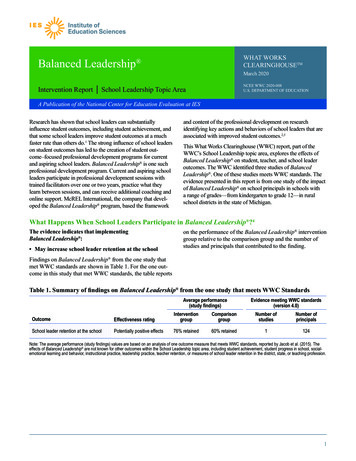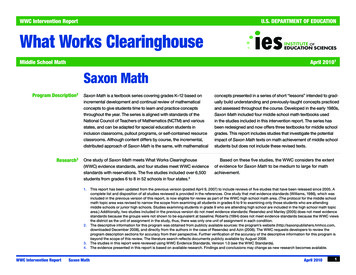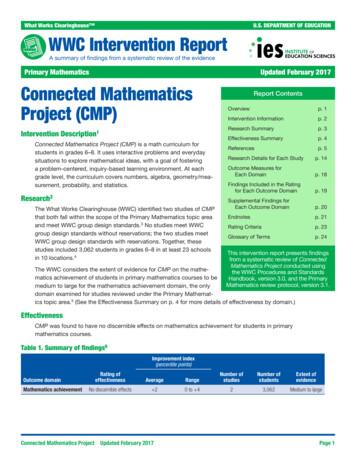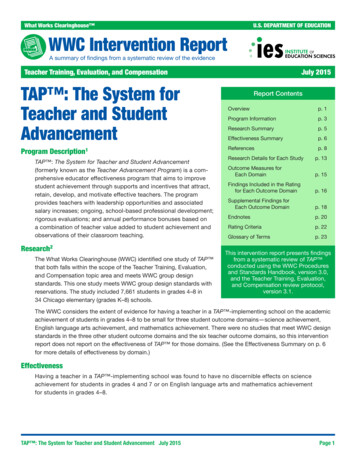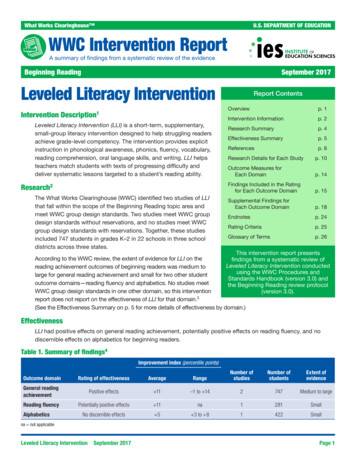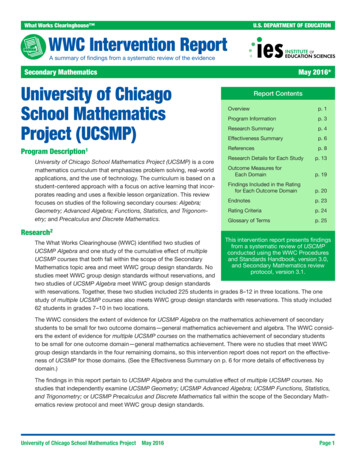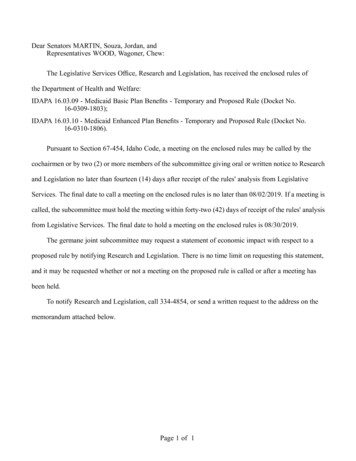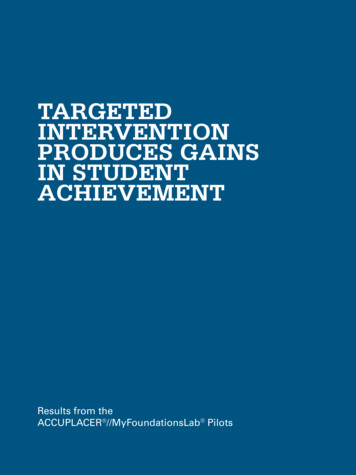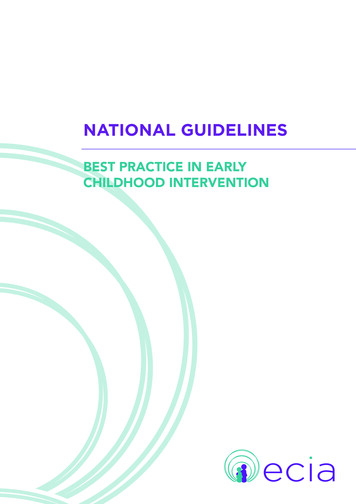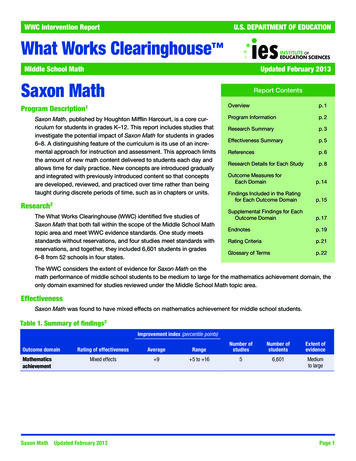
Transcription
WWC Intervention ReportU.S. DEPARTMENT OF EDUCATIONWhat Works Clearinghouse Middle School MathUpdated February 2013Saxon MathReport ContentsProgram Description1Saxon Math, published by Houghton Mifflin Harcourt, is a core curriculum for students in grades K–12. This report includes studies thatinvestigate the potential impact of Saxon Math for students in grades6–8. A distinguishing feature of the curriculum is its use of an incremental approach for instruction and assessment. This approach limitsthe amount of new math content delivered to students each day andallows time for daily practice. New concepts are introduced graduallyand integrated with previously introduced content so that conceptsare developed, reviewed, and practiced over time rather than beingtaught during discrete periods of time, such as in chapters or units.Research2The What Works Clearinghouse (WWC) identified five studies ofSaxon Math that both fall within the scope of the Middle School Mathtopic area and meet WWC evidence standards. One study meetsstandards without reservations, and four studies meet standards withreservations, and together, they included 6,601 students in grades6–8 from 52 schools in four states.Overviewp. 1Program Informationp. 2Research Summaryp. 3Effectiveness Summaryp. 5Referencesp. 6Research Details for Each Studyp. 8Outcome Measures forEach Domainp. 14Findings Included in the Ratingfor Each Outcome Domainp. 15Supplemental Findings for EachOutcome Domainp. 17Endnotesp. 19Rating Criteriap. 21Glossary of Termsp. 22The WWC considers the extent of evidence for Saxon Math on themath performance of middle school students to be medium to large for the mathematics achievement domain, theonly domain examined for studies reviewed under the Middle School Math topic area.EffectivenessSaxon Math was found to have mixed effects on mathematics achievement for middle school students.Table 1. Summary of findings3Improvement index (percentile points)Outcome domainMathematicsachievementSaxon MathRating of effectivenessAverageRangeNumber ofstudiesNumber ofstudentsExtent ofevidenceMixed effects 9 5 to 1656,601Mediumto largeUpdated February 2013Page 1
WWC Intervention ReportProgram InformationBackgroundOriginally developed by John Saxon, Saxon Math is distributed by Houghton Mifflin Harcourt SupplementalPublishers. Address: Specialized Curriculum Group, 9205 Southpark Center Loop, Orlando, FL, 32819. Email:greatservice@hmhpub.com. Website: www.saxonpublishing.com. Telephone: (800) 289-4490. Fax: (800) 289-3994.Program detailsThe Saxon Math curriculum consists of 120 daily lessons and 12 activity-based investigations for each grade level.Each lesson makes use of three strategies: The first strategy involves offering three types of activities: (a) fact-fluency practice that promotes recall whenworking with math operations and fractions, (b) mental math exercises intended to build number sense andproblem-solving strategies, and (c) practice solving challenging, non-routine story problems in which problemsolving strategies are emphasized. The second strategy is to limit the amount of new math content delivered to students each day. This strategyintroduces a relatively small set of new math ideas daily using examples, mathematical conversations, andpractice, and integrates the new concepts with ones that were previously introduced. The third strategy involves written practice that aims to help students both master new skills and maintaintheir mastery of concepts previously instructed.Students complete written, cumulative assessments after every five lessons. The results of these assessments provideteachers with data for instructional decision making and provide feedback for students and parents. In addition tothese written assessments, students may demonstrate mastery of math content through alternate interactive opportunities, such as investigations, test-day activities, and performance tasks.Currently Saxon Math for middle school offers three textbooks (Saxon Math Course 1 for grade 6, Saxon MathCourse 2 for grade 7, and Saxon Math Course 3 for grade 8). Earlier versions of the curriculum offered differenttextbooks for middles school grades (Saxon 7/6, Saxon 8/7, Saxon Algebra ½, and Saxon Algebra 1). The studydescriptions provided in this report indicate the version of Saxon Math that was evaluated by the study authorsin cases in which that information is available.CostFor the 2012 publication of Saxon Math, the student edition for each course costs 70.15 per student for a hardcopy, 56.15 for an eBook, 17.35 for a one year subscription to an online edition, or 53.70 for a six year subscription to an online edition. The teacher’s manual costs 113.65 for a hard copy, 27.35 for a one year subscription toan online edition, or 85.25 for a six year subscription to an online edition. A teacher technology package is availablefor 225.75 that includes the Teacher’s Manual eBook and various electronic teaching and planning resources. Othermaterials, such as student workbooks, instructional presentations, and manipulative kits, are available and range inprice from 3.10 to 352.00.Saxon MathUpdated February 2013Page 2
WWC Intervention ReportResearch SummaryThe WWC identified 21 studies that investigated the effects of SaxonMath on the mathematics achievement of middle school students.Table 2. Scope of reviewed research4Grade6, 7, 8Delivery methodWhole classThe WWC reviewed 16 of those studies against group design evidencestandards. One study (Resendez & Azin, 2006) is a randomized conProgram typeCurriculumtrolled trial that meets WWC evidence standards without reservations.Four studies (Crawford & Raia, 1986; Peters, 1992; Resendez, Fahmy, & Manley, 2005, Cohort A; and Resendez,Fahmy, & Manley, 2005, Cohort F) are randomized controlled trials or quasi-experimental designs that meet WWCevidence standards with reservations.5 Those five studies are summarized in this report. Eleven studies do not meetWWC evidence standards. The remaining five studies do not meet WWC eligibility screens for review in this topicarea. Citations for all 21 studies are in the References section, which begins on p. 6.Summary of study meeting WWC evidence standards without reservationsResendez and Azin (2006) conducted a randomized controlled trial to investigate the effect of Saxon Math on mathachievement in one northeastern Ohio middle school and one southwestern Ohio junior high school.6 The schoolsserved sixth-, seventh-, and eighth-grade students living in urban and suburban locations. Classes were randomlyassigned to use Saxon Math or comparison curricula during the 2005–06 school year. The analysis sample included281 students in 14 Saxon Math classrooms and 219 students in 11 comparison group classrooms. Classes in theintervention group used one of four Saxon Math curricula: (a) Saxon 7/6, 2004–4th Ed., (b) Saxon 8/7, 2004–4th Ed.,(c) Saxon Algebra ½, 2004–3rd Ed., or (d) Saxon Algebra 1, 2003–3rd Ed. Classes in the comparison group usedeither a traditional basal program or a mixed curriculum consisting primarily of teacher-created materials.Summary of studies meeting WWC evidence standards with reservationsCrawford and Raia (1986) conducted a matched-comparison quasi-experiment to investigate the effect of SaxonMath on the math achievement of eighth-grade students in Oklahoma City Public Schools during the 1984–85school year. The analysis sample included 78 eighth-grade students (39 Saxon and 39 comparison) taught by fourteachers from four middle schools. Students in the intervention group used the Saxon Algebra ½ (1983) textbook,and students in the comparison group used the Scott Foresman Mathematics (1980) textbook.Peters (1992) conducted a randomized controlled trial in which the integrity of random assignment was compromisedbecause some students did not remain in the study group to which they were randomly assigned—students were reallocated between the intervention and comparison groups to accommodate scheduling difficulties and student requestsfor other course offerings. The study investigated the effect of Saxon Math on the math achievement of 36 “mathtalented” eighth-grade students (19 Saxon Math and 17 comparison) from one junior high school in Nebraska duringthe 1991–92 school year.7 The district borders two large cities (Lincoln and Omaha) and its students lived in rural andsuburban areas. Students in the intervention group used the Saxon Algebra 1 (1981) textbook, while students in thecomparison group used the University of Chicago School Mathematics Project (UCSMP) Algebra 1st-edition textbook.Resendez, Fahmy, and Manley (2005, Cohort A) conducted a matched-comparison quasi-experiment to investigate the effect of Saxon Math on the math achievement of sixth-, seventh-, and eighth-grade students in 25 middleschools located in rural, suburban, and urban districts in Texas. The intervention and comparison schools werematched based on average demographic characteristics such student ethnicity, poverty, English language proficiency, and mobility. The analysis sample included 1,472 students from 12 intervention schools who received threeyears of Saxon Math exposure in grades 6, 7, and 8 and 1,582 students from 13 comparison schools during the1998–99 through 2000–01 school years. Schools in the intervention group used three Saxon Math curricula (Saxon7/6, Saxon 8/7, and Saxon Algebra ½).8 The majority of schools in the comparison group used core basal mathcurricula implemented with a chapter-based approach to math instruction.Saxon MathUpdated February 2013Page 3
WWC Intervention ReportResendez, Fahmy, and Manley (2005, Cohort F) conducted a matched-comparison quasi-experiment to investigatethe effect of Saxon Math on the math achievement of sixth-, seventh-, and eighth-grade students in 20 middle schoolslocated in rural, suburban, and urban districts in Texas. The intervention and comparison schools were matchedbased on average demographic characteristics such student ethnicity, poverty, English language proficiency, andmobility. The analysis sample included 1,526 sixth-grade students from 10 intervention schools who received one yearof Saxon Math exposure and 1,407 students from 10 comparison schools during the 2003–04 school year. Schoolsin the intervention group used two Saxon Math curricula (Saxon 7/6 or Saxon 8/7).9 The majority of schools in thecomparison group used core basal math curricula implemented with a chapter-based approach to math instruction.Saxon MathUpdated February 2013Page 4
WWC Intervention ReportEffectiveness SummaryThe WWC review of Saxon Math for the Middle School Math topic area includes student outcomes in one domain:mathematics achievement. The findings below present the authors’ estimates and WWC-calculated estimates ofthe size and statistical significance of the effects of Saxon Math on the mathematics achievement of middle schoolstudents. For a more detailed description of the rating of effectiveness and extent of evidence criteria, see theWWC Rating Criteria on p. 21.Summary of effectiveness for the mathematics achievement domainFive studies that meet standards with or without reservations reported findings in the mathematics achievement domain.Resendez and Azin (2006) found, and the WWC confirmed, no statistically significant differences between theSaxon Math and comparison groups in the mathematics achievement domain. The WWC characterizes these studyfindings as an indeterminate effect.10Crawford and Raia (1986) reported one positive and statistically significant difference between the Saxon Mathgroup and the comparison group in the mathematics achievement domain. However, according to WWC calculations (correcting for clustering), this difference was not statistically significant.11 The average effect size is considered substantively important according to WWC criteria. Therefore, the WWC characterizes these study findings asa substantively important positive effect.Peters (1992) found, and the WWC confirmed, no statistically significant differences between the Saxon Math andcomparison groups in the mathematics achievement domain. The WWC characterizes these study findings as anindeterminate effect.Resendez, Fahmy, and Manley (2005, Cohort A) reported one positive and statistically significant differencebetween the Saxon Math group and the comparison group in the mathematics achievement domain. However,according to WWC calculations (correcting for clustering), this difference was not statistically significant. The WWCcharacterizes these study findings as an indeterminate effect.Resendez, Fahmy, and Manley (2005, Cohort F) reported one positive and statistically significant difference betweenthe Saxon Math group and the comparison group in the mathematics achievement domain. However, according toWWC calculations (correcting for clustering), this difference was not statistically significant. The average effect size isconsidered substantively important according to WWC criteria. Therefore, the WWC characterizes these study findingsas a substantively important positive effect.Thus, for the mathematics achievement domain, there were two studies showing substantively important positiveeffects and three studies showing indeterminate effects, with no studies showing a statistically significant or substantively important negative effect. This results in a rating of mixed effects, with a medium to large extent of evidence.Table 3. Rating of effectiveness and extent of evidence for the mathematics achievement domainRating of effectivenessCriteria metMixed effectsEvidence of inconsistent effects.In the five studies that reported findings, the estimated impact of the intervention on outcomes in the mathematicsachievement domain was two studies showing substantively important positive effects and three studies showingindeterminate effects.Extent of evidenceCriteria metMedium to largeFive studies that included 6,601 students in 52 schools reported evidence of effectiveness in the mathematicsachievement domain.Saxon MathUpdated February 2013Page 5
WWC Intervention ReportReferencesStudy that meets WWC evidence standards without reservationsResendez, M., & Azin, M. (2006). Saxon Math randomized control trial: Final report. Jackson, WY: PRES Associates, Inc.Studies that meet WWC evidence standards with reservationsCrawford, J., & Raia, F. (1986). Analyses of eighth grade math texts and achievement. Oklahoma City, OK: OklahomaCity Public Schools, Planning, Research, and Evaluation Department.Peters, K. G. (1992). Skill performance comparability of two algebra programs on an eighth-grade population.Dissertation Abstracts International, 54(01), 77A. (UMI No. 9314428)Resendez, M., Fahmy, A., & Manley, M. A. (2005). Cohort A. The relationship between using Saxon Middle SchoolMath and student performance on Texas statewide assessments. Retrieved from df/s/SXMath Middle TX research web.pdfResendez, M., Fahmy, A., & Manley, M. A. (2005). Cohort F. The relationship between using Saxon Middle SchoolMath and student performance on Texas statewide assessments. Retrieved from df/s/SXMath Middle TX research web.pdfStudies that do not meet WWC evidence standardsBaldree, C. L. P. (2003). The effectiveness of two mathematical instructional programs on the mathematics growthof eighth grade students (Unpublished doctoral dissertation). University of Georgia, Athens. The study doesnot meet WWC evidence standards because the intervention and comparison groups are not shown to beequivalent at baseline.Clay, D. W. (1998). A study to determine the effects of a non-traditional approach to Algebra instruction on studentachievement (Unpublished master’s thesis). Salem-Teikyo University, Salem, WV. (ERIC Document ReproductionService No. ED428963). The study does not meet WWC evidence standards because the measures of effectiveness cannot be attributed solely to the intervention—there was only one unit assigned to one or both conditions.Imrisek, J. P. (1989). Incremental development: A more effective means of mathematics instruction? (Unpublishedmaster’s thesis). Bloomsburg University, PA. The study does not meet WWC evidence standards because themeasures of effectiveness cannot be attributed solely to the intervention—there was only one unit assignedto one or both conditions.Lafferty, J. F. (1996). The links among mathematics text, students’ achievement, and students’ mathematics anxiety: A comparison of the incremental development and traditional texts. Dissertation Abstracts International,56(08), 3014A. (UMI No. 9537085) The study does not meet WWC evidence standards because the measuresof effectiveness cannot be attributed solely to the intervention—there was only one unit assigned to one orboth conditions.Rentschler, R. V. (1994). The effects of Saxon’s incremental review on computational skills and problem-solvingachievement of sixth-grade students. Dissertation Abstracts International, 56(02), 484A. (UMI No. 9518017)The study does not meet evidence standards because the measures of effectiveness cannot be attributedsolely to the intervention—there was only one unit assigned to one or both conditions.Resendez, M., & Azin, M. (2007). The relationship between using Saxon Elementary and Middle-School Math andstudent performance on California statewide assessments. Jackson, WY: Saxon. The study does not meet WWCevidence standards because the intervention and comparison groups are not shown to be equivalent at baseline.Additional source:Resendez, M., & Azin, M. (2007). Saxon Math and California English learner’s math performance: Researchbrief. Jackson, WY: Saxon.Saxon MathUpdated February 2013Page 6
WWC Intervention ReportResendez, M., & Azin, M. (2008). The relationship between using Saxon Math at the elementary and middle schoollevels and student performance on the North Carolina statewide assessment. Jackson, WY: PRES Associates,Inc. The study does not meet WWC evidence standards because the intervention and comparison groups arenot shown to be equivalent at baseline.Resendez, M., & Manley, M. A. (2005). The relationship between using Saxon Elementary and Middle School Mathand student performance on Georgia statewide assessments. Orlando, FL: Harcourt Achieve. The study doesnot meet WWC evidence standards because the intervention and comparison groups are not shown to beequivalent at baseline.Roberts, F. H. (1994). The impact of the Saxon Mathematics program on group achievement test scores. DissertationAbstracts International, 55(06), 1498A. (UMI No. 9430198) The study does not meet evidence standardsbecause the measures of effectiveness cannot be attributed solely to the intervention—there was only oneunit assigned to one or both conditions.Saxon, J. (1982). Incremental development: A breakthrough in mathematics. Phi Delta Kappan, 63(4), 482–484.The study does not meet evidence standards because the measures of effectiveness cannot be attributedsolely to the intervention—there was only one unit assigned to one or both conditions.Walsh, T. J. (2009). The effect of Saxon Math on student achievement of sixth-grade students. DissertationAbstracts International, 70(06A). (AAI3362003) The study does not meet WWC evidence standards becausethe intervention and comparison groups are not shown to be equivalent at baseline.Studies that are ineligible for review using the Middle School Math Evidence Review ProtocolAndrus, H. A. (2005). Metacognitive instruction in the realm of sixth grade Saxon Math (Unpublished doctoraldissertation). Mount Mary College, Milwaukee, WI. The study is ineligible for review because it does notuse a comparison group design or a single case design.Fitzpatrick, S. B. (2001). An exploratory study of the implementation of an educational technology in two eighthgrade mathematics classes. Dissertation Abstracts International, 62(06), 2082A. (UMI No. 3016656) The studyis ineligible for review because it does not examine the effectiveness of an intervention.Harris, K. L. (2008). Saxon Math: An analysis for middle school students at-risk of low performance (Unpublisheddoctoral dissertation). Capella University, Minneapolis. The study is ineligible for review because it does notuse a comparison group design or a single-case design.McNeil, N., Grandau, L., Knuth, E., Alibali, M., Stephens, A., Hattikudur, S., & Krill, D. (2006). Middle-school students’understanding of the equals sign: The books they read can’t help. Cognition and Instruction, 24(3), 367–385.The study is ineligible for review because it does not include an outcome within a domain specified in the protocol.Williams, D. D. (1986). The incremental method of teaching Algebra I. Kansas City: University of Missouri. The studyis ineligible for review because it does not use a sample within the age or grade range specified in the protocol.Saxon MathUpdated February 2013Page 7
WWC Intervention ReportAppendix A.1: Research details for Resendez & Azin, 2006Resendez, M., & Azin, M. (2006). Saxon Math randomized control trial: Final report. Jackson, WY:PRES Associates, Inc.Table A1. Summary of findingsMeets WWC evidence standards without reservationsStudy findingsOutcome domainSample sizeAverage improvement index(percentile points)Statistically significantMathematics achievement500 students 8NoSettingThe study took place in one junior high school located in a suburban area of southwesternOhio and one middle school located in a large city in northeastern Ohio. The junior high schoolserved students in grades 7–9. The middle school served students in grades 5–8.Study sampleThe study sample included 543 sixth-, seventh-, and eighth-grade students in 25 classes(14 intervention classes with 303 students and 11 comparison classes with 240 students) fromtwo Ohio schools during the 2005–06 school year.12 Of the total study sample, about 49%were male (49% intervention and 50% comparison), 8% were special education students(7% intervention and 10% comparison), and 25% received free or reduced-price lunch (19%intervention and 33% comparison). Approximately 81% were Caucasian (91% interventionand 70% comparison), 17% were African American (8% intervention and 28% comparison),and 2% were of other racial/ethnic classifications (1% intervention and 3% comparison). Noneof the study sample was limited English proficient. Based on pretest percentile rankings, 18%were in the lowest quartile (10% intervention and 29% comparison), 29% were in the highestquartile (43% intervention and 11% comparison), and the remaining 53% were in the twomiddle quartiles (48% intervention and 60% comparison).13 The intervention and comparisongroups were formed through random assignment at the classroom level. There were seventeachers across the two schools. Six of the seven participating teachers taught at least oneintervention and one comparison class. This provides an opportunity for spillover (contamination)of the intervention to the comparison group, but the report concludes that contamination wasnot a problem. The seventh teacher was randomly assigned to teach one Saxon Math class.The analysis sample included 500 students for the TerraNova Math Total test (281 interventionand 219 comparison) and 492 students for the TerraNova Math Computation Total test (280intervention and 212 comparison).14InterventiongroupSaxon MathStudents in the intervention group were taught using one of four Saxon Math curricula duringthe 2005–06 school year: (a) Saxon Math 7/6, (b) Saxon Math 8/7, (c) Saxon Algebra ½, or(d) Saxon Algebra 1. Teachers were expected to implement key program components thatincluded: warm-up activities; teaching a new lesson concept; lesson practice; “mixed practice”that reviewed and built upon previous concepts and prepared students for upcoming lessons;teacher-directed, whole-class investigations; and test day activities.15 According to the studyauthors, two of the seven teachers typically did not follow the implementation guidelines.However, the majority of intervention classrooms (10 out of 14) covered at least 83% of the120 or more Saxon Math lessons.16Updated February 2013Page 8
WWC Intervention ReportComparisongroupThe math curriculum used in comparison classrooms varied by site. In the junior high school,comparison classrooms were taught using an unspecified traditional basal program for mathinstruction that used a modular approach, emphasized real-world application, and incorporateda variety of activities including exploration, modeling, and using tools such as technology tocommunicate math. In the middle school, comparison classrooms were taught using a variety ofresources consisting primarily of teacher-created materials based on district and state guidelines. The curriculum also included an Internet-based math program, traditional chapter-basedtextbooks, and other supplemental math resources.Outcomes andmeasurementThe primary outcome measures were the TerraNova Math Total and the TerraNova MathComputation Total of the CTB/McGraw-Hill TerraNova Basic Multiple Assessment with PlusTest. The pretest administration occurred between September and October 2005. The posttestadministration occurred between May and June 2006. For a more detailed description of theseoutcome measures, see Appendix B.Support forimplementationTeachers received about three hours of training before implementing the Saxon Math curricula.The Saxon Math trainer covered the program’s philosophy, key components, and curriculumsupport materials. A follow-up training session conducted in October/November providedteachers with one-on-one suggestions for using the program.Saxon MathUpdated February 2013Page 9
WWC Intervention ReportAppendix A.2: Research details for Crawford & Raia, 1986Crawford, J., & Raia, F. (1986). Analyses of eighth grade math texts and achievement. Oklahoma City, OK:Oklahoma City Public Schools, Planning, Research, and Evaluation Department.Table A2. Summary of findingsMeets WWC evidence standards with reservationsStudy findingsOutcome domainSample sizeAverage improvement index(percentile points)Statistically significantMathematics achievement78 students 16NoSettingStudy sampleThe study took place in four middle schools in Oklahoma City Public Schools.The study sample included 78 eighth-grade students (39 intervention and 39 comparison)taught by four teachers in four Oklahoma middle schools during the 1984–85 school year.17Each teacher taught an intervention class and a comparison class. The authors did not reportdemographic information. To create similar intervention and comparison groups, the researchersconducted a stratified matching procedure based on pretest total math score on the CaliforniaAchievement Test (CAT) at the student level, within teachers, to match a comparison studentto each student in the intervention group. When more than one student from the comparisongroup matched a student in the intervention group, the student match was selected at random.When no student from the comparison group matched a student in the intervention group, thestudent in the intervention group was excluded from the sample.InterventiongroupStudents in the intervention group were taught using the Saxon Algebra ½ (1983) textbookduring the 1984–85 school year. Information about the level of implementation was not provided. The intervention was implemented by four teachers, one from each of four schools.Each of these teachers taught intervention classes and comparison classes.ComparisongroupStudents in the comparison group were taught using the math textbook in place prior to thepilot study, Scott Foresman Mathematics (1980).Outcomes andmeasurementSupport forimplementationSaxon MathThe primary outcome measure was the total math score on the CAT. Pretest data were from theyear-end administration of the CAT in 1984, and posttest data came from the end-of-year testadministration in 1985. For a more detailed description of this outcome measure, see Appendix B.Information on teacher training was not provided.Updated February 2013Page 10
WWC Intervention ReportAppendix A.3: Research details for Peters, 1992Peters, K. G. (1992). Skill performance comparability of two algebra programs on an eighth-gradepopulation. Dissertation Abstracts International, 54(01), 77A. (UMI No. 9314428)Table A3. Summary of findingsMeets WWC evidence standards with reservationsStudy findingsOutcome domainSample sizeAverage improvement index(percentile points)Statistically significantMathematics achievement36 students 6NoSettingThe study took place in one junior high school in Nebraska. The district borders two large cities(Lincoln and Omaha) and has a mix of students living in rural and suburban locations.Study sampleThe study sample included two classrooms of the same eighth-grade teacher (for a total of36 students) from one junior high school during the 1991–92 school year. All of the studentswere “math talented” based on teacher recommendations and prior academic achievement.No information is provided on the specific thresholds that were used in delineating the mathtalented criteria; however, all students scored at or above the 87th percentile on the CAT totalmath battery. Of the total sample, 56% were female (58% intervention and 53% comparison)and 44% were male (42% intervention and 47% comparison). Students were randomlyassigned to the teacher’s two classrooms, and the teacher used the intervention in one classroom and the comparison curriculum in the other classroom.18 However, the assignment ofstudents was altered after random assignment to accommodate scheduling difficulties andstudent requests for other course offerings. The analysis sample included 19 students in theSaxon Math group and 17 students in the UCSMP Algebra group.InterventiongroupStudents in the intervention group were taught using Saxon Algebra 1 (1981) during the 1991–9
Saxon Math, published by Houghton Mifflin Harcourt, is a core cur-riculum for students in grades K-12. This report includes studies that investigate the potential impact of . Saxon Math. for students in grades 6-8. A distinguishing feature of the curriculum is its use of an incre-mental approach for instruction and assessment. This approach .
